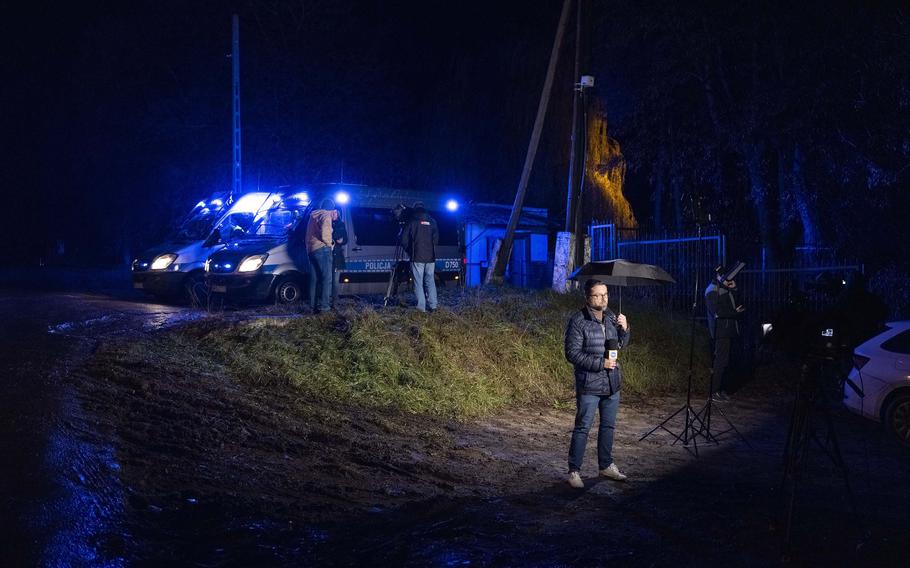
A television reporter stands near the spot where a missile killed two people in Poland. (Karolina Jonderko/The Washington Post)
The Associated Press sent a terrifying news alert around the world on Tuesday.
“A senior U.S. intelligence official says Russian missiles crossed into NATO member Poland, killing two people,” the AP wrote shortly before 2 p.m. The news agency noted the Polish government had not confirmed the information but that “top leaders were holding an emergency meeting due to a ‘crisis situation.’”
This seemingly dire development of Russian missiles striking a member nation of an American-supported international military alliance was sent to and seen by thousands of news outlets. Some, such as Reuters, repeated it, citing the AP alert.
There were cable news banners that blared that “Russian missiles” had landed in Poland. Social media influencers began speculating about whether NATO members might invoke a mutual defense pact and retaliate against Russia, potentially escalating its invasion of Ukraine to a global conflict.
But one day later, the original AP story has been taken offline and replaced with a correction note. The anonymous source was wrong and “subsequent reporting showed that the missiles were Russian-made and most likely fired by Ukraine in defense against a Russian attack,” it read.
By that point, NATO Secretary General Jens Stoltenberg had already told reporters as much. The explosion in Przewodow, Poland, was most likely caused by a Ukrainian air defense missile gone astray while defending against a Russian barrage.
News organizations can and do make mistakes: a misspelled name, a misidentified suspect, sometime even a retracted story. But rarely is flawed reporting a cause for international panic. And the AP was not alone. Its initial report was followed by a day of hype and hand-wringing across media platforms.
Just minutes after the AP alert, a Fox News broadcast report cited a “senior U.S. official” and “reports on the ground” that a “Russian missile, fired somewhere off of Ukraine” struck Poland. A CNN web update reported that Poland “confirms a Russian-made missile” was responsible for the blasts without mentioning that the Ukrainian military also uses Russian-manufactured weapons. “’Russian bombs’ kill two in POLAND,” the Daily Mail wrote.
Even when journalists reported cautiously, and many did in the uncertain hours after the incident, nuance got lost in translation. On the CBS Evening News, reporter Chris Livesay emphasized that the missiles could have been Russian or Ukrainian. But the CBS tweet with his report declared, “RUSSIAN MISSILE STRIKE: Two Russian missiles crossed over the Ukrainian border into Poland, a NATO country, killing two civilians.”
AP spokesperson Lauren Easton said Wednesday that the news organization was “looking into exactly what happened” with its initial alert. Many news companies, including The Washington Post, routinely reprint the news agency’s reporting.
Easton noted that the AP updated its report multiple times as new information emerged. An advisory sent to newsrooms shortly after midnight early Wednesday warned that a new assessment from three U.S. officials “contradicts information” in the original article, which was finally taken offline and replaced with a correction note that afternoon. The confusion was, in some ways, a fog-of-war moment for the news media where breaking events spread across a broad battlefield are not clear. Initial reports can turn out to be inaccurate or misleading.
Early on in the invasion of Ukraine, many outlets reported a sad but inspiring story sourced to Ukrainian officials: A cadre of soldiers defending Snake Island had refused to surrender to a Russian warship, standing their ground until they were all killed. The story became a viral rallying cry for supporters of Ukraine. It later emerged that some of those soldiers were actually captured and survived.
Reporters try to navigate the chaos of breaking news by relying on trusted, knowledgeable sources, as the AP apparently did by citing a senior U.S. intelligence official on Tuesday afternoon, albeit an unnamed one.
Newsrooms generally use anonymous sources only when they have no other option, mindful that readers tend to distrust them, sometimes with good reason. The AP policy states that anonymous sources can only be used if the information is vital, not available except under anonymity, and the source is reliable “and in and position to have direct knowledge of the information.” A news manager also has to sign off and know the identity of the source.
The alarming reports from Poland had a legitimate context: They came on the same day the Russian military fired dozens of missiles at Ukrainian civilian energy infrastructure. But many outlets refrained from speculating on the source of the missile that hit Polish territory and, in this case, caution proved the better move. Within a few hours, U.S. and European officials were tamping down fears that this was a deliberate Russian attack.
After convening an emergency meeting with NATO leaders and others early Wednesday, President Biden emerged and told reporters that a Russian attack on Poland appeared “unlikely” to have happened. Stoltenberg ruled it out several hours later, though he did not absolve Russia of responsibility. “The whole incident is caused by Russia’s brutal war in Ukraine,” Stoltenberg said.